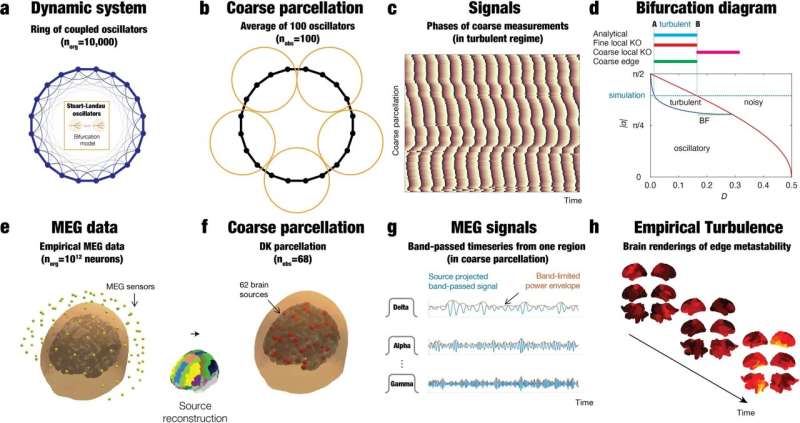
In a new tour-de-force neuroscientific study, led by the UPF Center for Brain and Cognition (CBC) and Centre for Eudaimonia and Human Flourishing at the University of Oxford, researchers found that efficient information transfer across the whole brain depends on turbulence by demonstrating turbulence in the fast neuronal brain dynamics directly measured with magnetoencephalography.
Originally coined “turbolenza” by Leonardo DaVinci over 500 years ago, turbulence has shown to be ubiquitous in nature as an essential dynamical regime facilitating energy and efficient information transfer across spatiotemporal scales.
This is the result of a study conducted by researchers from the CBC at UPF, the University of Oxford, and also the University of Indiana, whose results are presented in the article “The effect of turbulence in brain dynamics information transfer,” recently published in Communications Physics.
The co-authors of the paper are Gustavo Deco (CBC-UPF), Samuel Liebana Garcia (University of Oxford), Yonatan Sanz Perl (CBC-UPF), Olaf Sporns (University of Indiana), and Morten L. Kringelbach (University of Oxford).
New turbulence-based biomarker
The new fundamental finding of turbulence as key to information processing in the human brain can be used to build new biomarkers for disease. Turbulence is something most people primarily associate with whirlpools or with frightening experiences aboard airplanes.
But first and foremost, turbulence is a fundamental principle in nature providing the optimal mixing properties, allowing for the efficient transfer of energy and information over space and time. Turbulence has been shown to be the optimal way of cascading energy across spacetime over many scales and as such a fundamental organizing principle of physical systems.
This has important practical implications such as the insight that it is much better to use turbulent stirring while cooking since this helps mix ingredients optimally. Equally, turbulence also is used to find more energy-efficient ways of improving chemical plants, airplanes and windmills.
The new measure of local metastability measures changes in the continuous dynamic motions of neurons’ electrical fluxes on a spatial and temporal scale. This new measure is what constitutes the new biomarker for detecting neuropsychiatric disease or for differentiating between different brain states, as explained by the main author of the article and researcher at the UPF’s CBC, Professor Gustavo Deco: “In this study, we have created a new perspective to analyze brain dynamics, which allows generating new biomarkers that are potentially useful in neuropsychiatry.”
Professor Morten L Kringelbach, the senior author, adds “The results provide fundamental new insights into how turbulence, and more generally thermodynamics, are the key principles allowing the brain to survive and thrive.”
The creation of this new unit of measure has been fundamental to be able to study more precisely than in previous research how information and energy are transmitted efficiently within the brain through neural turbulence. Previously, turbulence had been measured using functional MRI, which is an indirect, slow measure of neuronal activity, dependent on the levels of oxygenation in the blood.
As such fMRI does not directly measure the electrical signals of neurons, and captures them with a delay (or latency), which corresponds to the time it takes the blood to respond to brain signals.
The first time turbulence has been shown in fast whole-brain dynamics
To overcome the limitations of functional MRI, researchers used the technique of magnetoencephalography (MEG) to analyze turbulence in the brain as a whole. MEG directly measures the electrical signals of neurons over milliseconds and therefore captures them immediately, capturing rapid time scales of brain dynamics over milliseconds, compared to over seconds with fMRI. However, MEG spatial accuracy is only around 5 mm3 which is not as high as the 1mm3 afforded by fMRI.
This new measuring system has been applied to the brain activity in the cortical regions of 89 healthy people. The results use whole-brain modeling to demonstrate that brain turbulence is critical for transmitting information and energy efficiently within the brain in both space and time.
With a view to the future, the researchers plan to test this new sensitive turbulence-based biomarker also subcortical regions. These include regions of the brain important for such diseases as Parkinson’s or Huntington’s. While their effects are also found in the cortex, examining the subcortical regions could advance further early diagnosis, and potential prevention or treatment.
Universitat Pompeu Fabra – Barcelona

